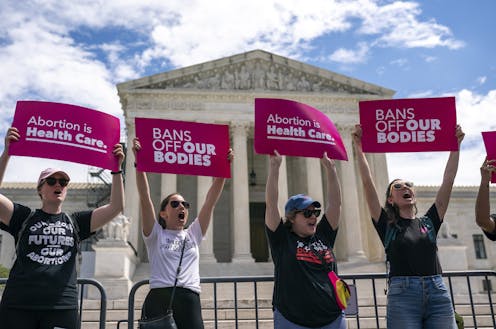
June 24 marks the one-year anniversary of the United States Supreme Court overturning Roe v. Wade — the landmark decision that, for nearly 50 years, had guaranteed abortion care access in the U.S.
As of June 16, 20 states have banned or heavily restricted access to abortion. At best, these bans require women who need abortions to travel hours, or even days out-of-state, often at a significant cost.
In response to this legislative change, many companies in the U.S. — including Goldman Sachs, the Bank of America, Dick’s Sporting Goods and Meta — introduced benefits to support employees needing abortions and other reproductive health care (e.g., birth control and genetic testing).
JPMorgan Chase, for example, is covering costs for employees who must travel more than 50 miles. Amazon is offering up to US$4,000 in travel expenses each year for medical treatments. By offering such benefits, employers are prioritizing employee health and safety, even when the law may not.
Dark side of workplace health benefits
Unfortunately, workplace health and safety initiatives have historically demonstrated that even the most well-intentioned benefits can have a dark side. For example, some health promotion programs have led to weight-based discrimination in the workplace.
Similarly, workplaces that adopt anti-harassment policies, but fail to have appropriate training, risk unintentionally causing backlash against women in the workplace.
If implemented poorly, health and safety benefits related to abortion may have similar unintended consequences, potentially putting already vulnerable employees at risk of being discriminated against at work. The mere presence of inclusive health and safety benefits is not enough. Authentic, consistent organizational support is critical.

Our research on related topics, including pregnancy, pregnancy loss, mental health and grief, provides actionable, evidence-based insight for employers and managers.
Build awareness of benefits
Many employees don’t access benefits because they don’t know the benefits exist. Employees often have low levels of awareness about the policies, programs and benefits their employer offers, particularly when those benefits are not discussed openly.
To build awareness, employers should share information about reproductive health-care benefits widely, freely and frequently. All messaging should be clear and use non-judgmental language.
Employers should also offer additional, but complementary benefits and resources, such as inclusive mental health (e.g., counselling) and physical health (e.g., physical therapy) support.
Improve access to benefits
Even when employees are aware of benefits, they may be unsure about how to access them. Bureaucratic red tape, such as paperwork or complicated human resource websites, can discourage, limit and prevent the use of benefits. To improve access to abortion care benefits, employers can do a number of things.
First, employers should ensure employees can safely and confidentially access abortion-related benefits. Employers should protect their employees’ privacy and dignity.

Second, employers should offer flexible, paid time off to minimize financial insecurity issues that could limit benefit use. Travelling to access abortion care out-of-state may take a week or more, and could require hospital stays and multiple nights of accommodation.
Lastly, employers should recognize that, even when out-of-state travel is not required, the physical recovery associated with an abortion often requires at least one full day of reduced activity. However, this can vary across individuals and procedures.
Reduce abortion and benefit stigma
Another significant barrier to using abortion benefits is the stigma associated with it. Employees seeking abortion care may fear that disclosing this information to their manager or co-workers could jeopardize their job security or result in them being viewed negatively.
To reduce the stigma associated with abortion and abortion-related benefits, there are a number of things employers can do. First, they should offer equitable, accessible health-care leave policies and travel funding that don’t require detailed disclosure or justification.
Second, employers should provide managers with appropriate training on benefit promotion and implementation. Managers must not only understand how employees can access and use policies and benefits, but also how they can support employees as managers. This may involve authorizing paid time off and offering temporary flexible work arrangements.
Lastly, managers should be trained on how to use de-stigmatizing language and show appropriate social support toward an employee if they disclose the need or desire to use abortion care benefits. Managers often set the tone within their teams and can dictate whether employees feel safe to use benefits and accommodations.
Abortion is a workplace issue
As stated by the New York Times, “abortion is a business issue.” By offering abortion care benefits and policies, employers serve as a “firewall” to protect against harmful legislation.
But to be effective, employers must promote and de-stigmatize reproductive health and abortion care benefits by normalizing them. Human resource professionals and front-line managers must be trained on how to discuss these benefits and support any employees who use them.
In addition, these benefits must be known about and easily accessible to employees — only then will employers avoid the dark side of well-intentioned, but poorly implemented abortion care benefits and policies.
Jennifer Dimoff receives funding from SSHRC and the University of Ottawa.
Jacquelyn Brady receives funding from San Jose State University.
Mikaila Ortynsky receives funding from SSHRC and the University of Ottawa.
Stephanie Gilbert receives funding from SSHRC and Cape Breton University.
This article was originally published on The Conversation. Read the original article.







